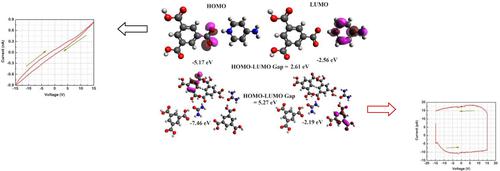当前位置:
X-MOL 学术
›
ChemistrySelect
›
论文详情
Our official English website, www.x-mol.net, welcomes your
feedback! (Note: you will need to create a separate account there.)
1,3,5‐Benzene Tricarboxylic Acid Based Cocrystals With Selective Semiconductivity via H‐coupled Charge Transfer
ChemistrySelect ( IF 1.9 ) Pub Date : 2024-02-22 , DOI: 10.1002/slct.202304666 Sudip Sarkar 1, 2 , Suranjan Shil 3 , Gobinda Chandra De 2 , Sushobhan Ghosh 1
ChemistrySelect ( IF 1.9 ) Pub Date : 2024-02-22 , DOI: 10.1002/slct.202304666 Sudip Sarkar 1, 2 , Suranjan Shil 3 , Gobinda Chandra De 2 , Sushobhan Ghosh 1
Affiliation

|
Two organic cocrystals, one (1) based on benzene 1,3,5 tricarboxylic acid (TMA) plus 4‐amino pyridine and another (2) based on benzene 1,3,5 tricarboxylic acid (TMA) plus urea is reported. Cocrystals 1 and 2 are fully characterized by single crystal X ray diffraction, NMR and IR spectroscopy. The single crystal X ray diffraction shows the intermolecular H‐bonding interaction between components of the pairs TMA‐TMA as well as TMA‐4 amino pyridine and TMA‐Urea molecules. The conductivity studies for the cocrystal 1 shows semiconducting behavior whereas cocrystal 2remain as insulator under the same experimental condition. Computational studies with theoretically optimized structures as well as experimental X‐ray structures of both the cocrystals reveal the origin of conductivity as the H‐atom coupled charge transfer through the intermolecular H‐bonding between TMA and 4‐amino pyridine in cocrystal 1.
中文翻译:

通过氢耦合电荷转移具有选择性半导性的 1,3,5-苯三甲酸基共晶
报道了两种有机共晶体,一种 (1) 基于苯 1,3,5 三羧酸 (TMA) 加 4-氨基吡啶,另一种 (2) 基于苯 1,3,5 三羧酸 (TMA) 加尿素。共晶 1 和 2 通过单晶 X 射线衍射、核磁共振和红外光谱进行了充分表征。单晶 X 射线衍射显示了 TMA-TMA 组分对以及 TMA-4 氨基吡啶和 TMA-尿素分子之间的分子间氢键相互作用。共晶 1 的电导率研究显示出半导体行为,而共晶 2 在相同的实验条件下仍保持绝缘体状态。对两种共晶的理论优化结构和实验 X 射线结构进行的计算研究揭示了电导率的起源,即通过共晶 1 中 TMA 和 4-氨基吡啶之间的分子间氢键进行氢原子耦合电荷转移。
更新日期:2024-02-22
中文翻译:

通过氢耦合电荷转移具有选择性半导性的 1,3,5-苯三甲酸基共晶
报道了两种有机共晶体,一种 (1) 基于苯 1,3,5 三羧酸 (TMA) 加 4-氨基吡啶,另一种 (2) 基于苯 1,3,5 三羧酸 (TMA) 加尿素。共晶 1 和 2 通过单晶 X 射线衍射、核磁共振和红外光谱进行了充分表征。单晶 X 射线衍射显示了 TMA-TMA 组分对以及 TMA-4 氨基吡啶和 TMA-尿素分子之间的分子间氢键相互作用。共晶 1 的电导率研究显示出半导体行为,而共晶 2 在相同的实验条件下仍保持绝缘体状态。对两种共晶的理论优化结构和实验 X 射线结构进行的计算研究揭示了电导率的起源,即通过共晶 1 中 TMA 和 4-氨基吡啶之间的分子间氢键进行氢原子耦合电荷转移。




















































 京公网安备 11010802027423号
京公网安备 11010802027423号